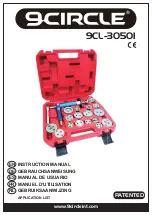
5
PLACING TOOL IN SERVICE
6.
To decrease the delivered torque, rotate the Sleeve
clockwise (when facing the square driver) one or more
numbers and slide it back into full engagement with the
teeth on the Torsion Bar and Anvil.
To increase the delivered torque, rotate the Sleeve
counterclockwise (when facing the square driver) one or
more numbers and slide it back into full engagement with
the teeth on the Torsion Bar and Anvil.
7.
Turn the Jig Adjusting Screw counterclockwise until the
tension is released and there is play in the Torque Jig
Arm.
8.
Loosen the Eyebolt Thumb Nut and remove the tool from
the Jig.
Do not loosen the Thumb Nut while the Torque Arm
Jig is stressed.
9.
Install the Torque Locking Sleeve Retainer and run at
least six nuts or screws before checking the torque.
Adjusting an Unstressed Torsion Bar Using a
Screw Type Jig
Always use a Right–Hand Torque Setting Jig for
right–hand thread applications; use a Left–Hand Torque
Setting Jig for left–hand thread applications. Make
certain the Torsion Bar being adjusted has the proper
permanent set in the stress beam for the application on
which it is to be used.
1.
Slide the Torque Locking Sleeve, numbered end first,
over the square driver of the Torsion Bar and rotate it
counterclockwise for right–hand tools (clockwise for
left–hand tools) when facing the square driver, selecting
the last position where it will slide into engagement with
both the Anvil and Torsion Bar.
2.
Turn the Jig Adjusting Screw until the Jig Arm Trunion is
located at the lowest position on the threaded portion of
the Screw.
Use only right–hand Jigs for right–hand adjustment
and left–hand Jigs for left–hand adjustment.
3.
Position the tool in the Jig so that the marked tooth on the
Anvil is visible. Enter the square driver of the Torsion
Bar to full depth in the square recess in the Torque Jig
Arm and mate the teeth on the Anvil with those in the
Torque Jig Clamp. Swing the other Torque Jig Clamp
(splined or smooth) over the top of the Anvil.
4.
Swing the Jig Clamp Eyebolt into the slot in the Clamp
and securely tighten the Eyebolt Thumb Nut.
5.
Note the number on the Torque Locking Sleeve that is in
alignment with the marked anvil tooth.
6.
Slide the Locking Sleeve forward, disengaging it from the
Anvil. Rotate the Sleeve four numbers (positions)
counterclockwise for right–hand adjustment, clockwise
for left–hand adjustment, and start it onto the Anvil in
the new position.
7.
Slowly turn the Jig Adjusting Screw clockwise until the
Torque Locking Sleeve, in its new position, can be slid
over the Torsion Bar to full engagement.
8.
Turn the Jig Adjusting Screw counterclockwise until the
tension is released and there is play in the Torque Jig
Arm.
9.
Loosen the Eyebolt Thumb Nut and remove the tool from
the Jig.
Do not loosen the Thumb Nut while the Torque Arm
Jig is stressed.
10. Install the Torque Locking Sleeve Retainer and run at
least six nuts or screws before checking the torque.
Trip Valve Plunger Arm Adjustment
The Trip Valve Plunger Arm is threaded onto the Trip
Valve Plunger to provide longitudinal adjustment. The
Arm is properly adjusted at the factory and readjustment
should not be necessary as long as the original parts
continue in use. However, installation of a new Planet
Gear Frame, Gear Case, Motor Housing, Hammer or
Hammer Case may make readjustment necessary.
Adjustment is also required whenever a new Trip Valve
Plunger Arm or Trip Valve Plunger, which always
includes the Arm, is installed.
If, after replacement of any of the above mentioned parts,
the Impactool either fails to stop automatically, or stops
prematurely after the first few blows, it is an indication
that the Plunger Arm should be reset. To reset the Plunger
Arm, proceed as follows:
1.
Remove the Plunger Bushing Plug from the Hammer
case.
2.
Insert a small screwdriver into the slot on the end of the
Trip Valve Plunger and rotate the Plunger, 1/2 turn at a
time, clockwise if the Impactool failed to stop, or
counterclockwise if the Impactool stopped prematurely.
Total rotation of the Plunger should not exceed two
complete revolutions in either direction. If improper
operation continues after completing two revolutions,
the malfunction is the result of some other cause.





































